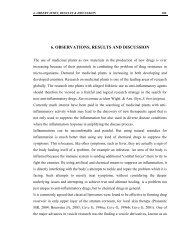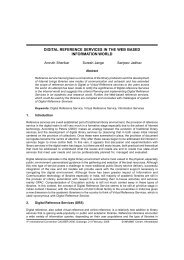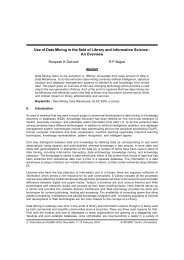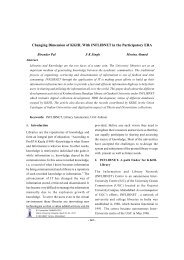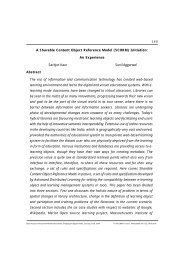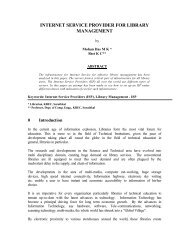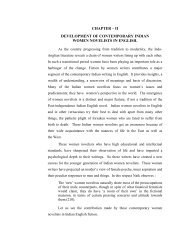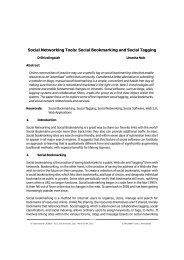Planning for Library Automation: Academic Libraries - DSpace ...
Planning for Library Automation: Academic Libraries - DSpace ...
Planning for Library Automation: Academic Libraries - DSpace ...
- No tags were found...
Create successful ePaper yourself
Turn your PDF publications into a flip-book with our unique Google optimized e-Paper software.
<strong>Planning</strong> <strong>for</strong> <strong>Library</strong> <strong>Automation</strong>: <strong>Academic</strong> <strong>Libraries</strong> 20------------------------------------------------------------------------------------------------------------------------------------------? ADDITIONS TO THE EXISTING SYSTEM may be required to maintain per<strong>for</strong>mancespecifications, to accommodate new users, or to allow <strong>for</strong> additional automated functions.SYSTEM SPECIFICATIONSAt some point, you will need to re-<strong>for</strong>mulate your functional priorities into "functional specifications,"which may be defined as what you want an automated system to do <strong>for</strong> you, including things that yourcurrent manual system cannot do. "Technical specifications" must also be established. These includestandards that must be adhered to, system per<strong>for</strong>mance, operation, and maintenance, as well asinfrastructure requirements, such as stable sources of electricity and telecommunications, and sufficientbandwidth.Developing clear and accurate functional and technical specifications that are specific to your library isone of the most important, if not THE most important, activity that you will engage in as you plan <strong>for</strong>your automated system. These specifications will carry you through the entire procurement process, andwill ensure that the system which most closely matches them will be the most useful and the mostresponsive to your needs.DEVELOPING A FORMAL SPECIFICATIONS DOCUMENTIt is very difficult to compare systems sensibly and pragmatically solely by randomly looking at systems,talking to sales representatives, reading literature or comparing broad cost quotations. For this reason,libraries use a <strong>for</strong>mal document -- often known as a "Request <strong>for</strong> Proposal," or RFP -- that organizes andstandardizes the in<strong>for</strong>mation provided to and requested from the various system vendors.Utilizing an RFP to solicit written responses from vendors makes it possible <strong>for</strong> you to systematicallycompare functionality, cost, maintenance, support, and all the other issues that are involved in systemprocurements. The process can save you money and will result in a wiser decision.An RFP document should include these essential elements, among others:? background in<strong>for</strong>mation on the library;? a description of how the proposals should be arranged and submitted;? instructions on receiving vendor business and financial in<strong>for</strong>mation;? criteria the library will use to evaluate vendor proposals;? questions regarding vendor training and documentation;? your functional and technical specifications.Also, vendors should be asked to describe:? how they will create bibliographic, item and borrower databases;? their system maintenance programs and services;? their site preparation requirements;? their delivery and installation methodologies;? their system per<strong>for</strong>mance guarantees; and? their pricing and cost strategies, in detail.-----------------------------------------------------------------------------------------------------------------------------------------------------INFLIBNET Regional Training Programme in <strong>Library</strong> <strong>Automation</strong> (IRTPLA) 2004© INFLIBNET Centre, University Grants Commission, Ahmedabad-380009, India




